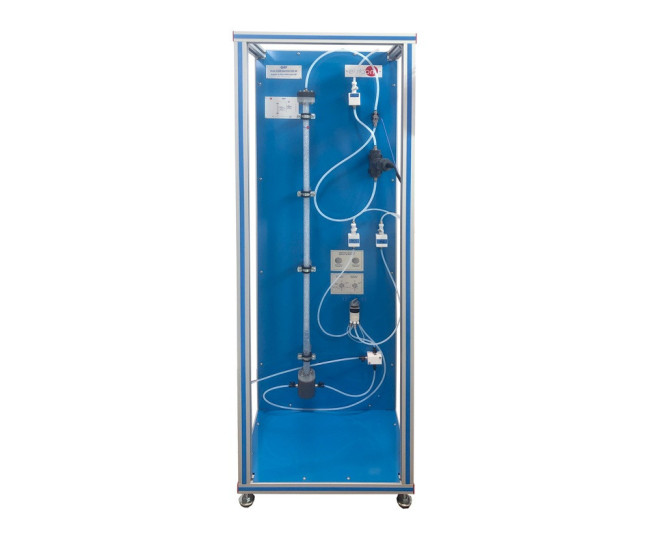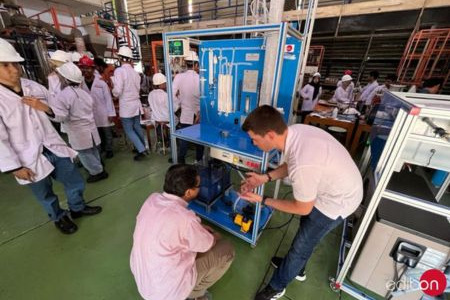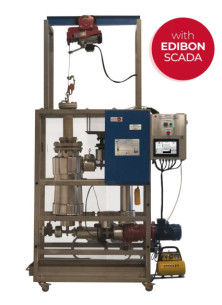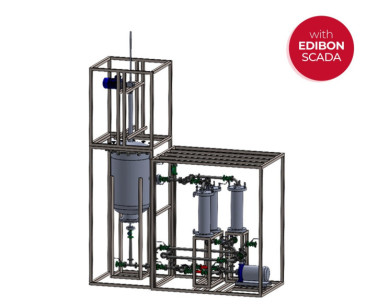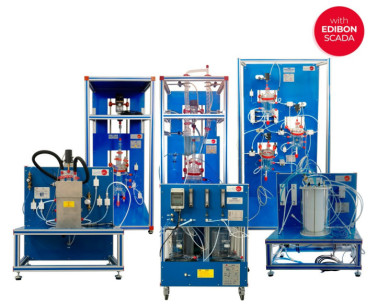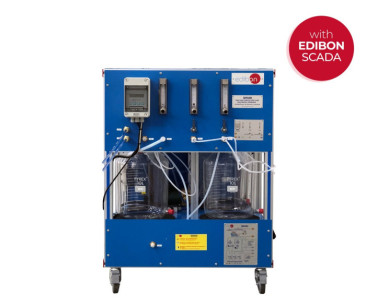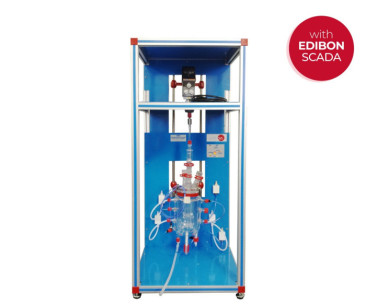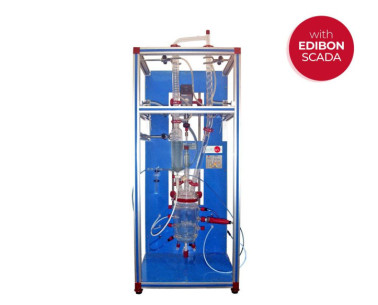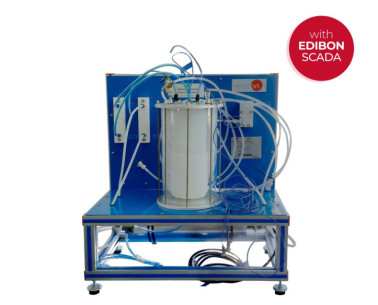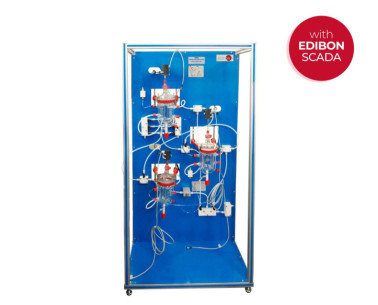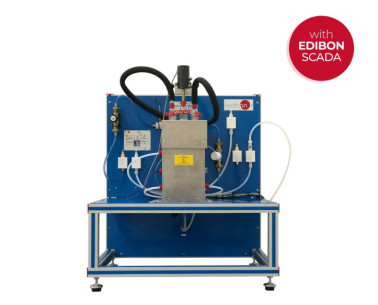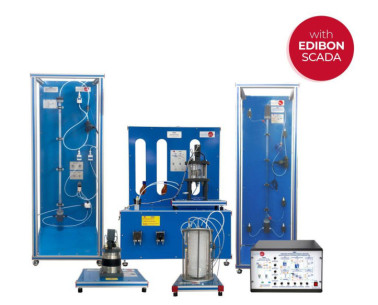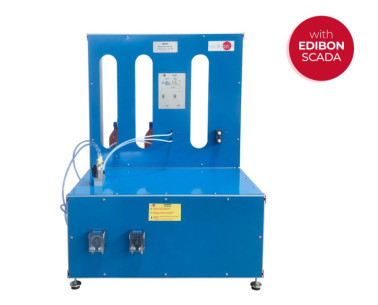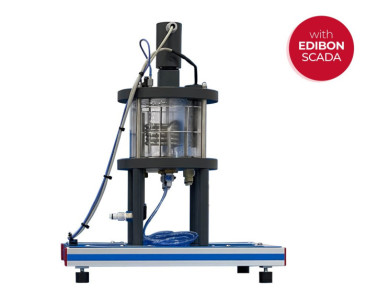Today we would like to tell you about our latest installation in Indonesia. At Institut Teknologi Sepuluh Nopember we have installed the following equipment. Our engineers came to the centre to install the equipment and explain how it works to the people responsible for using it.
QRP Reator de Fluxo de Pistão
SISTEMAS INOVADORES
The Plug Flow Reactor for QR, "QRP", designed by EDIBON, allows studying and investigating the kinetics of reactions and flow behavior in chemical systems. A plug flow reactor is a type of tubular reactor that assumes the assumption of no axial mixing of components along its length.
NOTÍCIAS RELACIONADAS
Descrição Geral
The Plug Flow Reactor for QR, "QRP", designed by EDIBON, allows studying and investigating the kinetics of reactions and flow behavior in chemical systems. A plug flow reactor is a type of tubular reactor that assumes the assumption of no axial mixing of components along its length.
This type of reactor requires the application of a series of specific formulas over a volume differential instead of over the total volume, as is the case with perfectly mixed reactors. This reactor enables the determination of key kinetic equations, such as the basic hydrolysis of ethyl acetate, which is fundamental for the design and optimization of industrial processes. It facilitates comparative analysis between theoretical and experimental conversion values, enhancing understanding of chemical processes. Additionally, it examines the effect of flow rate and feed concentration on reaction efficiency and selectivity. Its ability to investigate the influence of temperature on laminar flow characterization is essential for optimizing chemical processes under variable conditions.
Furthermore, it studies the reactor’s response to disturbances, such as pulses and step changes, providing vital information for the design and control of industrial chemical processes.
In summary, the piston flow reactor enables a wide range of practices and experiments, making it an invaluable tool for researchers, educators, and industry professionals seeking to understand and optimize complex chemical processes.
To work with this reactor, the Base and Service Unit, "QUS", is required, which supplies the necessary reagents and thermostatic water for proper operation.
EXERCÍCIOS E PRÁTICAS GUIADAS
EXERCÍCIOS PRÁTICOS GUIADOS INCLUÍDOS NO MANUAL
- Determination of the residence time distribution of the reactor.
- Effect of flow rate and feed concentration on the determination of flow pattern.
- Study of the reactor response to different perturbations: step and pulse change.
- Effect of flow rate and feed concentration on the steady state conversion.
- Demonstration of the flow pattern in the reactor and comparison with the theoretical model.
- Determination of the steady state conversion of a second order reaction.
- Understanding the principles of tracer techniques in flow pattern characterisation.
- Conductivity measurement system: conductimeter.
EQUIPAMENTOS COMPLEMENTARES
11.2.- REATORES QUÍMICOS
ACCR/20/CTS
The Computer Controlled and Touch Screen 20 l Anti-Corrosive Circulation Reactor, "ACCR/20/CTS", is able to show, for further research and study, the fractionation of biomass into its three components of interest: high quality cellulose,...
ENERGIA
ACCR/250/CTS
Computer Controlled and Touch Screen 250 l Anti-Corrosive Circulation Reactor
The Computer Controlled and Touch Screen 250 l Anti-Corrosive Circulation Reactor, "ACCR/250/CTS", is able to show, for further research and study, the fractionation of biomass into its three components of interest: high quality cellulose,...
11.2.- REATORES QUÍMICOS
QRQC
Sistema de Treinamento em Reatores Químicos Controlado por Computador (PC)
The Computer Controlled Chemical Reactors Training System, "QRQC," has been designed by EDIBON to facilitate advanced study for students, professors and researchers on the attributes, scenarios, and various types of reactors prevalent in the...
11.2.- REATORES QUÍMICOS
QRUBI
Unidade Base e de Serviço para QRQC
The Base Service Unit, "QRUBI", provides the necessary elements for the operation of the different reactor modules.It performs the following functions:Liquid reagent feeding: comprised of two 10-liter glass tanks, two dosing pumps with a capacity...
11.2.- REATORES QUÍMICOS
QRIA
Reator Isotérmico com Agitador
The Stirred Isothermal Reactor, "QRIA," designed by EDIBON, provides a controlled and uniform environment for carrying out chemical reactions. This reactor is essential for advancing knowledge in the fields of chemistry and process engineering,...
11.2.- REATORES QUÍMICOS
QRIA/D
Reator Isotérmico com Agitador e Destilação
The Isothermal Reactor with Stirrer and Distillation, "QRIAD/D," designed by EDIBON, enables the calculation and comparison of kinetic constants, as well as the determination of activation energy for the studied reactions. This reactor is...
11.2.- REATORES QUÍMICOS
QRFT
Reator de Fluxo Tubular
The Tubular Flow Reactor, "QRFT," specifically designed by EDIBON, is intended for the kinetic study of liquid-liquid homogeneous reactions. This unit allows for a wide range of practices, including the determination of kinetic equations, the...
11.2.- REATORES QUÍMICOS
QRSA
Reatores com Agitador em Série
The Series Stirred Reactors, "QRSA," designed by EDIBON, provide the ability to investigate the kinetics of liquid-liquid homogeneous reactions and conduct experiments with multiple reactors in series. This configuration allows the outlet flow of...
11.2.- REATORES QUÍMICOS
QRAD
Reator Adiabático e Isotérmico
The Adiabatic and Isothermal Reactor, "QRAD", designed by EDIBON, is used as a calorimeter for the kinetic study of homogeneous liquid-liquid reactions.Characterized by maintaining a constant temperature with no heat exchange with the...
11.2.- REATORES QUÍMICOS
QRC
Reatores Químicos, Controlados por Computador (PC)
The Computer Controlled Chemical Reactors, "QRC", has been designed by EDIBON for the study and comparison of different types of chemical reactors in an easy and simple way and thus allowing, on a small scale, to carry out the necessary studies...
11.2.- REATORES QUÍMICOS
QUSC
Unidade Base e de Serviço para QRC
The Service Unit for QRC, "QUSC", provides the necessary elements for the operation of the different reactor modules. It performs the following functions:Reagent supply: consisting of two 1 l pyrex containers each located at the back, two dosing...
11.2.- REATORES QUÍMICOS
QRCAC
Reator Contínuo de Tanque Agitado para QRC, Controlado por Computador (PC)
The Computer Controlled Continuous Stirred Tank Reactor for QRC, "QRCAC", designed by EDIBON, provides a controlled environment for detailed kinetic study of homogeneous liquid-liquid chemical reactions. This type of reactor, also known as CSTR...
Qualidade

Serviço pós-venda

 Preferências de cookies
Preferências de cookies

